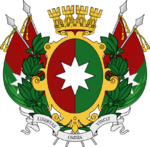Cutinsua: Difference between revisions
mNo edit summary |
mNo edit summary |
||
| Line 42: | Line 42: | ||
| image_map = | | image_map = | ||
| image_map_caption = | | image_map_caption = | ||
| capital = [[Andavaila]] <small>(''de facto'')</small> | | capital = [[Andavaila]] <small>(1344-1541, ''de facto'')</small><br>[[Čačapojas]] <small>(1541-1543, ''de facto'')</small> | ||
|official_languages = {{wp|Classical Quechua|Runanca}} | |official_languages = {{wp|Classical Quechua|Runanca}} | ||
|common_languages = {{wp|Aymara language|Kirua}}, others | |common_languages = {{wp|Aymara language|Kirua}}, others | ||
Revision as of 11:41, 2 October 2021
League of Five Cities Hunju Pičqantin Laqtakuna | |||||||||||||||||||
|---|---|---|---|---|---|---|---|---|---|---|---|---|---|---|---|---|---|---|---|
| 1344–1543 | |||||||||||||||||||
|
Attested banners of the League of Five Cities | |||||||||||||||||||
| Capital | Andavaila (1344-1541, de facto) Čačapojas (1541-1543, de facto) | ||||||||||||||||||
| Official languages | Runanca | ||||||||||||||||||
| Common languages | Kirua, others | ||||||||||||||||||
| Religion | Cutinsuan religion | ||||||||||||||||||
| Government | Hegemonic confederation of allied city-states | ||||||||||||||||||
| tbd | |||||||||||||||||||
• tbd | tbd | ||||||||||||||||||
| History | |||||||||||||||||||
• Formation of the League | 1344 | ||||||||||||||||||
• Conquest of Oruras | 13XX | ||||||||||||||||||
| 1543 | |||||||||||||||||||
| |||||||||||||||||||
| Today part of | |||||||||||||||||||
The League of Five Cities (Classical Runanca: Hunju Pičqantin Laqtakuna), more commonly known as Cutinsua (Classical Runanca: Sunquntinsuyu; Kirua: Lluquayllu), was an alliance of five Runanca city-states - Andavaila, Čačapojas, Suljanas, Lambajekė, and Akarajas - that ruled much of northern Aucuria from 1344 until its conquest by the Ruttish užkariautojas Jurgis Leikauskas in 1543.
The League of Five Cities was formed in response to the military expansion of the Kingdom of Oruras, which was perceived as an existential threat by its founding members. The League subsequently defeated and conquered Oruras in a series of wars, and expanded from its heartland in the Vaskaranas Mountains to control much of northern Aucuria through a mixture of diplomacy, assimilation, intimidation, and conquest. Though nominally an equal alliance between all five of the League's founding members, Andavaila quickly became the dominant member politically, economically, and militarily, steadily forcing the others into subsidiary roles.
At its peak, Cutinsua controlled almost all of northern Aucuria and some regions of northeastern Nuvania. Cutinsuan rule was hegemonic and often indirect, with local elites permitted to retain their titles if they paid tribute to the League and the leaders of polities that resisted replaced by semi-autonomous stewards appointed by Andavaila. Cutinsua developed a complex system of roads, inns, and warehouses to facilitate administration and trade, constructed monumental works of architecture, used knotted strings called kipu for record-keeping, and oversaw a flourishing of textile-making, metalworking, and agriculture. Notably, the empire functioned largely without money, with the exchange of goods & services handled through reciprocity and taxes paid through the mit'a and minka systems of corvée labor. Cutinsuan religion was highly polytheistic, centered around a litany of deities and sacred objects.
In 1541, Cutinsuan envoys met with Jurgis Leikauskas and invited him to Andavaila. While there, Leikauskas met with envoys from Čačapojas, Suljanas, and Akarajas who relayed to him their resentment of Andavailan dominance within the League. Leikauskas agreed to aid them in a rebellion against Andavaila, which saw forces from Andavaila and Lambajekė repeatedly defeated and Andavaila itself viciously sacked in October of the same year. Čačapojas, Suljanas, and Akarajas subsequently seized a leading role in a rump League of Five Cities; however, their relations with Leikauskas and his forces quickly broke down, and, by 1543, Ruttish užkariautojai had destroyed their former allies, completing the Ruttish conquest of Cutinsua.
While efforts were made to revive the League by several indigenous revolts, most famously the 1608-1612 Great Cutinsuan Revolt, none of these efforts were successful. Nonetheless, Cutinsuan and neo-Cutinsuan resistance to Ruttish and, later, Rudolphine colonialism became important symbolically to indigenous rights movements among the Runanca and Kirua in contemporary Aucuria.


